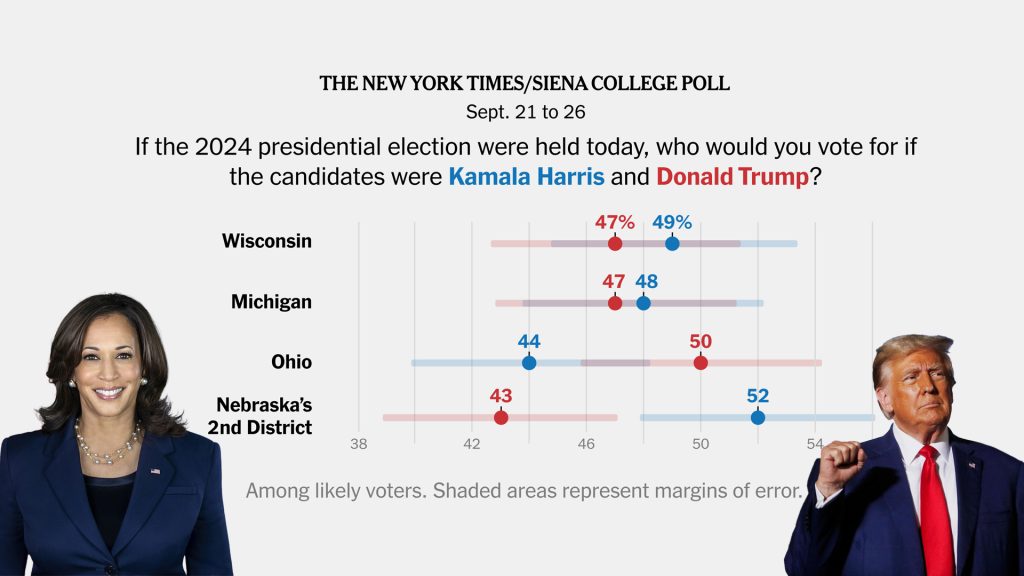
As the 2024 presidential election approaches, new polls reveal that Vice President Kamala Harris and former President Donald Trump are locked in a highly competitive race in the key battleground states of Michigan and Wisconsin. These two Midwestern states, which were pivotal in the 2020 election, are once again shaping up to be major determinants of who will occupy the White House in the next term. With both candidates focusing significant attention on these swing states, the tight margins suggest a heated contest that could go down to the wire.
Michigan: A Crucial Battleground
Michigan has long been seen as a swing state, with its diverse electorate and shifting political loyalties. In 2020, President Joe Biden narrowly reclaimed the state for the Democrats, winning by just over 150,000 votes. However, recent polling indicates that Michigan is once again up for grabs.
According to a survey conducted by a respected polling firm, Harris and Trump are currently neck and neck in Michigan, each securing around 47% of the vote among likely voters. The remaining voters are undecided or leaning toward third-party candidates, making the outcome of the state far from certain.
Harris, who has been actively campaigning in the state, has focused her messaging on economic recovery, healthcare access, and job creation—issues that resonate with Michigan’s working-class voters. She has also made a point of addressing environmental concerns, particularly around the Great Lakes, which are a critical resource for the state’s economy and identity.
On the other hand, Trump remains popular among Michigan’s rural voters and has retained strong support from manufacturing and agricultural communities. His message of economic nationalism and bringing jobs back to America continues to resonate with many Michiganders who feel left behind by globalization and trade policies.
Wisconsin: Another Key Swing State
Wisconsin, much like Michigan, was a key state in the 2020 election. Biden’s narrow victory in Wisconsin—by fewer than 21,000 votes—underscored just how tight the race could be in 2024. Now, with Trump seeking a comeback and Harris positioned as the Democratic frontrunner, the state is once again a focal point of both campaigns.
Recent polling shows that Harris and Trump are tied in Wisconsin, with each candidate pulling in approximately 48% of likely voters. Wisconsin’s electorate is notoriously difficult to predict, with rural areas leaning Republican and urban centers, such as Milwaukee and Madison, skewing heavily Democratic. This division makes the state a critical battleground where turnout efforts and campaign strategies will be decisive.
Harris has been emphasizing her commitment to healthcare, education, and social justice in Wisconsin, hoping to energize the Democratic base, particularly in urban areas and among younger voters. She has also made frequent references to her work with President Biden on pandemic recovery, aiming to showcase the administration’s achievements in guiding the country through a challenging period.
Trump, meanwhile, is focusing on law and order, tax cuts, and his record on deregulation, appealing to his core base in Wisconsin’s rural and suburban areas. His rallies in the state have drawn large crowds, and his campaign is banking on mobilizing voters who feel disillusioned by the current administration.
The Importance of the Midwest in 2024
Michigan and Wisconsin are part of the so-called “blue wall” that Democrats traditionally rely on to win presidential elections. However, Trump’s victories in these states in 2016 shocked the political world and signaled a realignment of the electorate. In 2020, Biden managed to rebuild that wall, but the latest polls suggest that the foundation remains shaky.
Both Michigan and Wisconsin are emblematic of larger trends in the Midwest, where voters’ concerns often revolve around economic issues, healthcare, and job security. These states have a high concentration of working-class voters who have been affected by the decline in manufacturing and the challenges of a globalized economy. As a result, candidates’ messaging on these topics will be crucial in swaying undecided voters.
The Midwest’s significance in the 2024 election cannot be overstated. With tight races in states like Pennsylvania and Ohio as well, Michigan and Wisconsin are critical pieces of the electoral puzzle. Winning these states could provide the margin needed for either Harris or Trump to secure victory in November.
The Role of Polls and Voter Turnout
While the polls show a tight race, it’s important to note that they are just a snapshot of the current political landscape. With months still to go before Election Day, both candidates have time to shift the narrative and make their case to voters. However, the close margins in these polls indicate that voter turnout will be a decisive factor.
In both Michigan and Wisconsin, the campaigns are ramping up efforts to register voters and get them to the polls. Early voting, mail-in ballots, and voter outreach are expected to play a significant role, particularly in a post-pandemic world where election dynamics have shifted. For Harris, driving turnout among young voters, minorities, and suburban women will be key to securing victories in these battleground states. For Trump, re-energizing his base, particularly in rural areas, and maintaining support among working-class white voters will be essential.
Conclusion: A Race Too Close to Call
As it stands, Michigan and Wisconsin are shaping up to be two of the most fiercely contested states in the 2024 presidential race. Polls show Kamala Harris and Donald Trump locked in a dead heat, with both candidates holding strong support in key demographic groups. The outcome in these states could very well determine the next occupant of the Oval Office, making them critical battlegrounds for both campaigns.
With both candidates pouring resources into these states and tailoring their messages to resonate with voters’ concerns, the race is far from over. As Election Day draws nearer, the margins in Michigan and Wisconsin are likely to remain tight, with the final result hinging on voter turnout and the ability of each candidate to sway undecided voters. One thing is clear: both Michigan and Wisconsin will once again be at the center of America’s political future.
